






The Information Technology (IT) ind computer systems, software, hardw Macomb Community College comm Needs Assessment to explore the cu Counties in Michigan Specifically, th job landscape, identify skill gaps and findings of this study will be critical f educational programs, and industry
The scope of research included a lab best practices review, and future tre was conducted of job postings durin made between the frequency of spe the availability of those skills in job-s
Employment prospects are also a ke employment in the IT sector betwee top jobs require a Bachelor’s degree postings However, there are a few o no degree Most notably, Computer the 3-county region and US overall occupation groups, although wages benchmarks
In addition to identifying skill gaps, a were three distinct skill groupings a For this analysis, there are two majo those skills that scored high in both survey of emerging and important s Reasoning, Problem-Solving, and ef
A survey and focus group were cond industry, including employers, educ these surveys suggest that turnover are quite high This may present cha process
When preparing to educate the wor reskilling plans for employers Traini many respondents This included in
Learner preferences were another fo preferences for learning, over 30 per workshops (273 percent) and on-the value of flexibility and accessibility, a


Specific IT-related credentials were an important highlight of the research, with strong agreement between labor market data and the industry survey Both data sets suggest a strong employer preference for credentials such as Microsoft Certified Professional, Amazon Web Services (AWS) Certified Solutions Architect, and Cisco Certified Network Associate
One survey item stood out from others, with 295 percent of respondents answering “lack of qualified candidates or limited talent availability” when asked about significant challenges in talent acquisition A follow-up to this question was explored during the focus group, where participants were asked what a “qualified” candidate means to them Surprisingly, educational credentials such as degrees or certifications were not a primary consideration for employers When asked about specific skills required for success in IT, respondents indicated communication, problem-solving, project and time management, and curiosity Few technical skills were mentioned, such as programming, cloud computing, and database management Regarding employer perspective of recent IT graduates’ career readiness, there is consensus that specialized skills are increasingly important This further supports the observation that careers in IT are highly diverse and can vary from one employer to another
To address several problems outlined in the research, a few key recommendations are offered First, portfolios showcasing contributions to projects are becoming more important, allowing hiring agents to assess a candidate’s abilities The focus group also suggested that short-term training, mock interviews, and resume preparation would be valuable
The research also included a review of best practices within the IT industry By integrating training programs with curricula, industry leaders and educational institutions can collaboratively foster a talent pipeline This should be a coordinated effort where all stakeholders are engaged in continuous dialogue to equip the workforce with the necessary skills for an evolving IT industry A framework of key actions from each of the following stakeholder groups is proposed to bridge these gaps: Employers, Employees/Job Seekers/Students, Education Providers, Policymakers, and Researchers
Specific training methods are also proposed, with four themes emerging as best practices First, hands-on learning has been shown to improve student comprehension and reduce failure rates The second theme is industry collaboration Programs like the Google IT certificate and the College Work Experience Program at the University of Central Florida, in collaboration with Lockheed Martin, provide students with practical skills and work experience Theme number three suggests that apprenticeships and mentorships hold tremendous value The fourth theme pertained to specific protocols, such as cohort-based learning, boot camps, web-based learning, and problem-based learning Prospective regional partnerships offering some of these protocols were also identified, including Code for Good, Girls Who Code, and others
The final component to this research included forecasting future trends and emerging technologies Based on the literature review and industry survey, a short list of trends were identified, including Artificial Intelligence, Encryption and Cyber Security, Cloud computing, and Immersive Reality technologies (AR & VR)
Phase one is comprised of two parts: Identifying IT Occupations and 1 Labor Market Analysis. 2.
Part one consists of several components: listing and validation of the IT Occupations, keyword analysis and occupation grouping. Including an outline of middle-skill jobs based on commonly accepted criteria for this classification.
Part two utilizes the existing IT group that has been highlighted in the WIN Labor Market reports for several years.
This group is made up of 16 individual occupations, each of which was previously identified by WIN and subsequently validated as being representative of the industry overall.



WIN conducted a cross-reference of these 16 occupations against those identified on the Bureau of Labor Statistics (BLS.gov) website for Computer and Information Technology Occupations. All occupations listed on BLS.gov are captured by the WIN Information Technology grouping. Below is a full list from BLS:
Computer and Information Research Scientists
Computer Network Architects
Computer Programmers
Computer Support Specialists
Computer Systems Analysts
Database Administrators and Architects
Information Security Analysts
Network and Computer Systems Administrators
Software Developers, Quality Assurance Analysts, and Testers
Web Developers and Digital Designers

WIN conducted a thorough examination of the industry affiliations for each occupation analyzed, finding a specific industry connected to every job listing. By analyzing the industry distribution among all 16 IT occupations, WIN pinpointed the industries that are most actively seeking IT professionals. This analysis encompassed both the broader categories of 2-Digit industries and the more detailed 4-Digit industries, each offering unique insights into industry composition.
2023-2024



The highest proportion of job postings for Information Technology workers was found in the Professional, Scientific, and Technical Services Industry, with 40.8 percent of the job postings. Management of Companies and Enterprises was a distant second with 10.2 percent. Rounding out the top three was the Finance and Insurance industry, with 10.0 percent.
2023-2024 4-DigitIndustryComposition AggregatedIndustry Composition(4-Digit)
The highest proportion of job postings for Information Technology workers was found in the Computer Systems Design and Related Services Industry, with 24.3 percent of the job postings. Management of Companies and Enterprises was second with 10.2 percent, followed closely by Architectural, Engineering, and Related Services with 6.5 percent.

Across job postings, there are three distinct skills groupings: software skills, common skills and specialized skills. Specialized skills are those considered necessary for the given occupations in which they appear. Among all 16 occupations in the WIN IT group, there are 26 skills characterized as "rapidly growing" relative to the market. This designation is given on the basis of having greater than 20.0 percent projected skill growth. Given the direct extraction from job postings, these keywords may also serve as a leading indicator of future skills demand



The dataset for specialized skills encompassed 50 top skills, with 8 among them approaching the threshold for being characterized as "rapidly growing" within 26 percent of the designation This is in addition to the existing 26 skills that already carry this label Notably, only 4 skills are characterized as "stable," and none indicate a decline This reinforces the notion that numerous IT careers are justifiably classified as "emerging," a topic that is explored further in this report
Across job postings, there are three distinct skills groupings: software skills, common skills and specialized skills. Common skills are those considered less technical in nature, but are still important for success in the occupation. Among all 16 occupations in the WIN IT group, there are 13 skills characterized as "rapidly growing" relative to the market This designation is given on the basis of having greater than 200 percent projected sk leading indi



The dataset for common skills encompassed 50 top skills, with 8 among them approaching the threshold for being characterized as "rapidly growing" within 2.8 percent of the cutoff. This is in addition to the existing list of 13 skills, shown above, which already hold the distinction. Furthermore, only 6 skills are characterized as "stable," while 4 skills were listed as "lagging" relative to the market.
Across job postings, there are three distinct skills groupings: software skills, common skills and specialized skills. Software skills are those considered essential to the core tasks of a given occupation. Among all 16 occupations in the WIN Information Technology group, there are 15 skills characterized as "rapidly growing" relative to the market. This designation is given on the basis of having greater than 20.0 percent projected skill gro indicato



The dataset for software skills encompassed 50 top skills, with 10 among them approaching the threshold for being characterized as "rapidly growing" within 26 percent of the designation This is in addition to the existing list of 15 skills, shown above, which already hold the distinction Furthermore, only 3 skills are characterized as "stable," while 3 skills were listed as "lagging" relative to the market
WIN has previously released reports on "Middle Skill" occupations to help identify those with lower educational and training requirements for entry Middle-skills jobs are those that require more than high school but less than a 4-year degree and pay over the state median wage of $2180 per hour There will be negative job growth in the coming years for jobs that currently only require a high school diploma and the jobs that will take their place are middle-skill Employment prospects for those with a degree are still bright and middle-skill jobs can be part of a career pathway into more education and even more lucrative employment With a shifting economic landscape, post-secondary training is more important than ever In this analysis, 2 occupations were identified as displaying Middle Skill characteristics within the 3-county region Additional consideration was given to the median wage and job growth of these respective occupations



Lightcast utilizes a linear growth model for projecting job gains in the next 10 years. According to the data, employment for Computer User Support Specialists are expected to decline by 3.7% (351 jobs) by 2033 while Computer Network Support Specialists are expected to grow by 3.9% (42 jobs) in the same time period.

The two middle skill occupations identified for the IT industry demonstrated a divergent pattern between 2013 and 2023. Despite the negative growth projection for Computer User Support Specialists between 2023-2033, this occupation demonstrates much higher total employment



Skill Shapes is a unique visualization which allows an easy comparison of the supply and demand for various skill sets in the analysis of job postings, as well as job seeker profiles Where the "% of Total Profiles" shape extends beyond the "% of Total Postings" shape, this indicates an over-supply of skills relative to demand Where the "% of Total Postings" shape extends beyond the "% of Total Profiles" shape, this indicates a supply shortage relative to demand For each of these skills areas, the top ten skills by posting frequency were selected


Information Technology (IT) jobs include occupations that are associated with entry-level, technical, and professional careers related to the design, development, support and management of hardware, software, multimedia, and systems integration services The Information Technology group is quickly growing, and about 4,300 job openings are reported in the area annually
EmploymentOverTime

According to 2023 Lightcast data, the 3-county region has 65,791 IT workers The workforce is not too diverse, with most workers identifying as male (739 percent) and between the ages of 25 and 54 (770 percent) Workers age 55 years and older account for 179 percent, while only 51 percent are 24 years old or younger Around 659 percent of the workforce identify as White, and workers who identify as Asian, make up 189 percent of the workforce
In 2023, there were a total of 38,151 job postings for IT workers, with Software Developers as the most sought-after occupation by IT industry employers, with 12,906 postings. Computer Occupations, All Other was in the second position with 8,287 postings. Other top posted jobs include Computer User Support Specialists (3,786 postings), Computer Systems Analysts (2,915 postings), and Software Quality Assurance Analysts and Testers (1,525 postings). Although the top IT jobs generally require a Bachelor’s degree, Computer User Support Specialists, typically require some college, no degree.
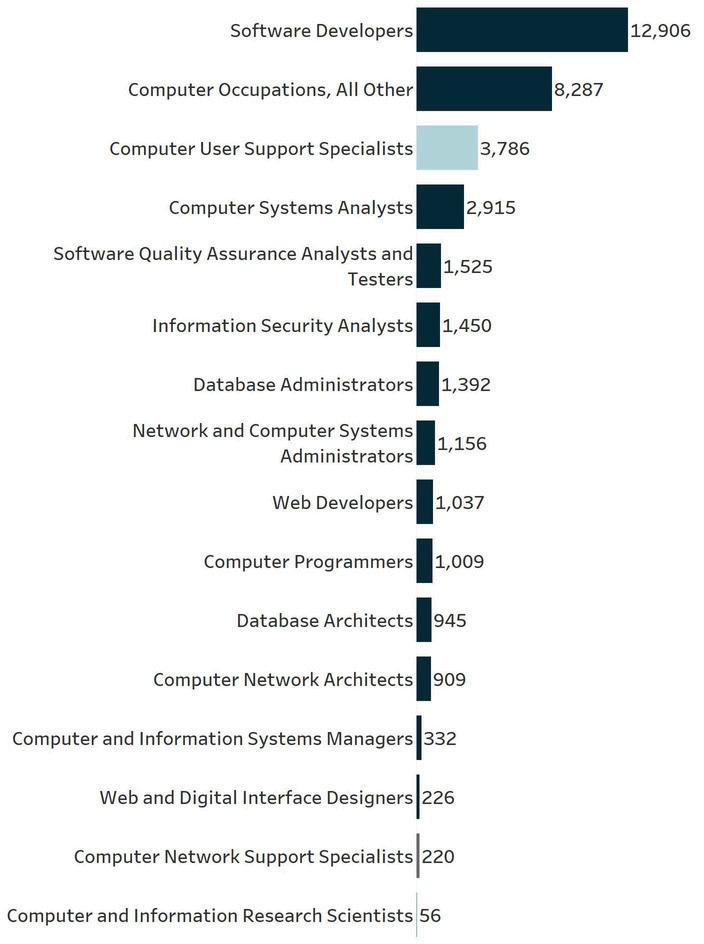

In-demand IT occupations provide high wages, even for those at entry-level and with fewer credentials. Software Developers, the most in-demand occupation, offers a median hourly wage of $50.45 per hour or almost $104,936 per year. Computer and Information Research Scientists earn the highest median wage at $64.37 per hour or nearly $133,889 per year. Other occupations that have fewer qualifications, such as Computer User Support Specialists and Web Developers and Digital Interface Designers, earn over $25.00 an hour.


Amongthe16identifiedIToccupations,12arerecognizedasemergingin-demandrolesatthe3-county region,comparedto15atthenationallevel.Furthermore,projectedjobgrowthfor2023-2033shows thatmostregionaloccupationsareexpectedtoexperiencesingle-digitpercentageincreases,whereas nationalprojectionsindicatedouble-digitgrowth Forinstance,thejobgrowthforcomputersystems analystsisanticipatedtobe0.2percentregionally,comparedto16.7percentnationally.Additionally, medianhourlyearningsforalloccupationsareconsistentlyhigheratthenationallevelthanatthe3countyregion.
NationalEmergingIn-DemandOccupations(2023-2033)
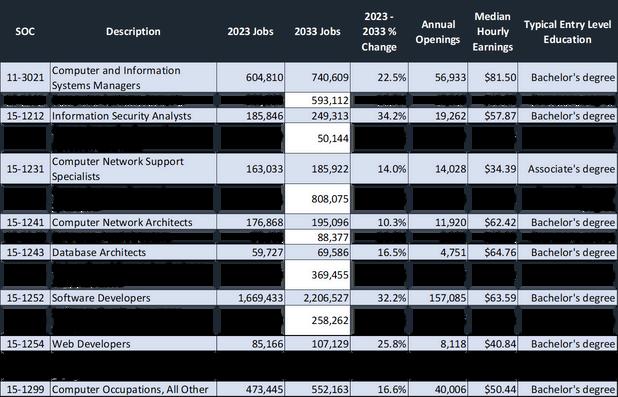
3-CountyRegionEmergingIn-DemandOccupations(2023-2033)

In2023,themostsought-afterspecializedskillsacrossjobpostingsincludeComputerscience,Python, softwareengineering,development,andautomation.Regionally,high-demandspecializedskillsinclude SystemsEngineeringandElectricalEngineering Nationally,thereisalsostrongdemandforskillssuch asAgilemethodology,projectmanagement,andAmazonWebServices NationalRapidGrowthSpecializedSkills(2023)

3-CountyRegionRapidGrowthSpecializedSkills(2023)
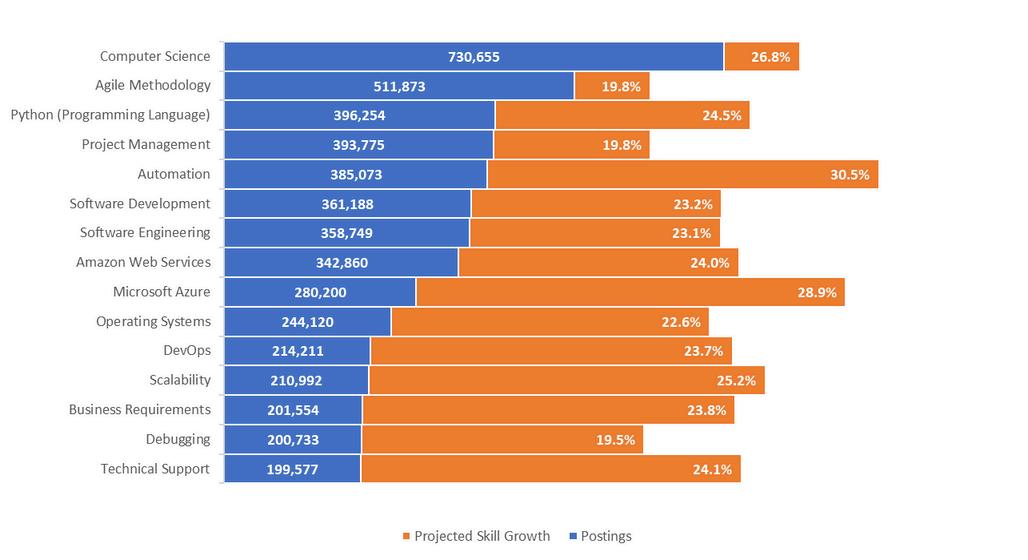


Thetopfivein-demandcommonskillsin2023areconsistentatboththenationalandregionallevels: informationtechnology,innovation,self-motivation,presentation,andprioritization.Theonlynotable differenceisthatmathematicsisahigh-demandcommonskillatthenationallevel,whereasitisnot experiencingthesamerapidgrowthregionally.
NationalRapidGrowthCommonSkills(2023)

3-CountyRegionRapidGrowthCommonSkills(2023)



Thetopfivein-demandsoftwareskillsin2023areconsistentatboththenationalandregionallevels: Python(ProgrammingLanguage),AmazonWebServices,MicrosoftAzure,operatingsystems,andJIRA However,therearekeydifferences:Docker,ServiceNow,andPowerBIareinhighdemandatthe nationallevel,whileSAPapplicationsandMicrosoftPowerBIaremoresoughtafterregionally
NationalRapidGrowthSoftwareSkills(2023)

3-CountyRegionRapidGrowthSoftwareSkills(2023)


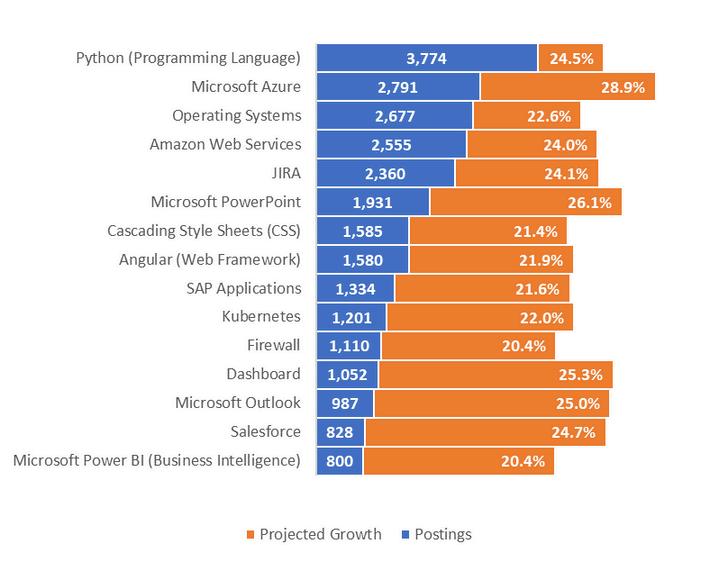
Middle-skilljobsarethosethatrequireeducationbeyondahighschooldiplomabutlessthanafour-year degree,withwagesexceedingthestatemedianof$2180perhour Twomiddle-skilloccupationsintheIT industryshoweddivergenttrendsbetween2013and2023.EmploymentforComputerUserSupport Specialistshassteadilyincreasedatboththenationalandregionallevelssince2013,despiteaslight declinein2023.Incontrast,employmentforComputerNetworkSupportSpecialistshasexperienceda slightdeclinesince2019atthenationallevelandsince2015attheregionallevel


Accordingto2024Lightcastdata,employmentforComputerUserSupportSpecialistsisprojectedtogrow by13.0%(93,041jobs)by2033,whileComputerNetworkSupportSpecialistsareexpectedtoseea14.0% increase(22,889jobs)overthesameperiod Inthe3-countyregion,however,employmentforComputer UserSupportSpecialistsisanticipatedtodeclineby3.7%(351jobs)by2033,whereasComputerNetwork SupportSpecialistsareprojectedtoexperiencemodestgrowthof39%(42jobs)duringthistimeframe


In2023,thetotalnumberofInformationTechnologyjobsintheU.S.is5,533,323,comparedto65,791inthe 6-countyregion NationalemploymentintheITsectorhascontinuedtogrowsince2013,althoughthe paceslowedsomewhatduringtheCOVID-19pandemic.Incontrast,employmentinthe3-countyregion experiencedasignificantdeclineduringthepandemicandhasnotyetfullyrecoveredtopre-pandemic levels
NationalITEmploymentOverTime(2013-2023)

3-CountyRegionITEmploymentOverTime(2013-2023)
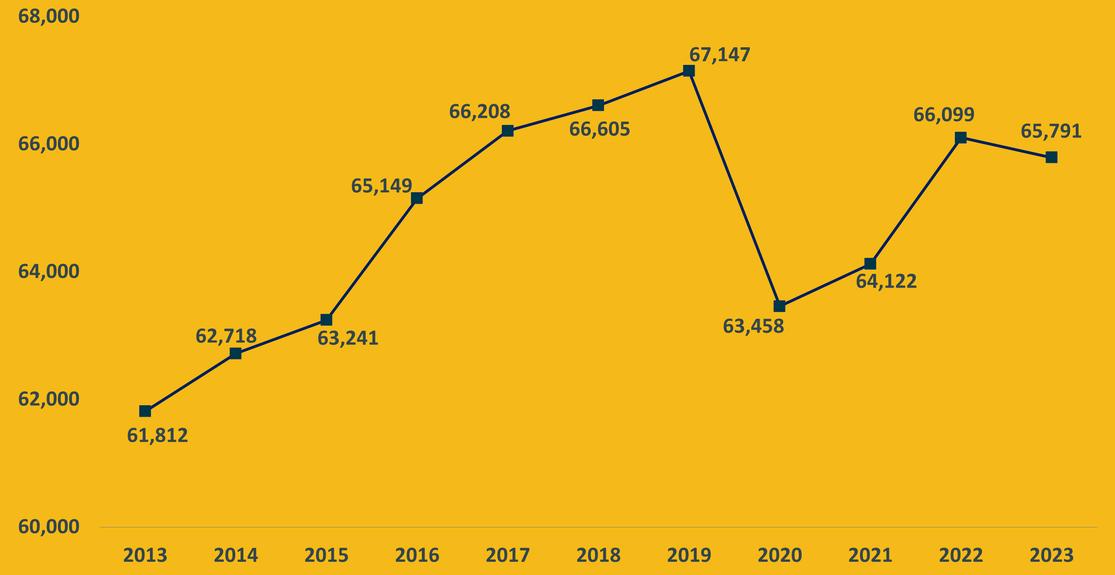
In2023,therewereatotalofapproximately2,590,000ITjobpostingsintheUnitedStatesand38,151 postingsinthe3-countyregion SoftwareDeveloperswerethemostsought-afteroccupation,with 768,826postingsnationallyand12,906postingsregionally.Thesecondmostcommoncategorywas ComputerOccupations,AllOther,with638,561postingsnationwideand8,287inthe3-countyarea Other toppostedjobsincludedComputerUserSupportSpecialists(273,900nationalpostingsand3,786regional postings)andComputerSystemsAnalysts(131,481nationalpostingsand2,915regionalpostings) While mosttopITpositionsgenerallyrequireaBachelor’sdegree,ComputerUserSupportSpecialiststypically requiresomecollegeeducationbutnotadegree.




During phases 2 and 3, the key objectives were to obtain primary data for core and soft skills These skills are critical for success within current and emerging information technology occupations.
The project plan for obtaining this data included surveys, interviews, and focus groups.

This study employs a mixed-methods approach, integrating both quantitative and qualitative data collection techniques The primary data sources include a structured survey and a focus group discussion The combination of these methods allows for a comprehensive understanding of the research questions, providing both breadth and depth in the data collected
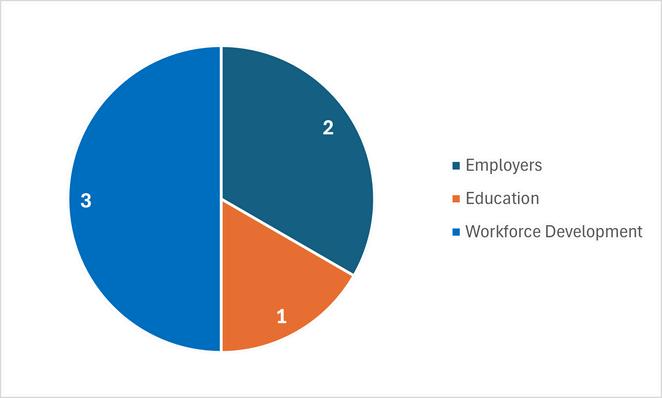
Population and Sample: The target population for this study comprises professionals working in the IT industry across various regions A sampling approach was used to ensure representation from different sectors of the workforce, including working professionals, IT employers, education, and workforce development
Sample Size: Over 1,300 participants were selected for the survey, while a smaller, more focused group of 15 participants was chosen for the focus group discussion. The survey participants were randomly selected from a larger database of IT professionals, whereas the focus group participants were comprised of volunteers from among the survey respondents.
Survey Instrument: A structured survey was developed, consisting of 22 multiple-choice or multipleselection questions and seven open-ended questions. The multiple-choice/selection questions were used to measure various aspects of IT skills, challenges, and industry needs. The open-ended questions were designed to gather more detailed insights into specific issues
Focus Group: A focus group was convened to facilitate the discussion, comprising seven open-ended questions designed to explore the themes identified in the survey in greater depth The questions focused on participants' experiences, perceptions, and recommendations regarding IT skills and industry challenges
Procedures: The survey was administered online using a survey platform (eg, Microsoft) Participants received an email invitation containing a link to the survey The survey was available for four weeks to ensure ample time for responses Reminder emails were sent midway through the survey period to encourage participation
The focus group was conducted in a virtual setting using video conferencing software (eg, Teams) The session lasted approximately 90 minutes and was moderated by a trained facilitator Participants were encouraged to share their views openly and interact with each other The session was audio-recorded with participants' consent for subsequent transcription and analysis
The survey explored participant backgrounds through questions about their tenure with current employers, years of IT experience, and primary service areas These inquiries aimed to gather insights into respondents' professional profiles, offering a snapshot of their experience levels and geographic service coverage Data collection included key stakeholders such as employers, industry associations, educational institutions, workforce development agencies, and IT professionals to understand and generalize their perspective on IT skills needs and challenges

Howmanyyearsofexperiencedoyou haveintheITfield?
In a survey, findings show that the majority of participants, representing 53.3 percent, possess over 10 years of experience in the IT field. Additionally, 8.8 percent of respondents have between 1 and 3 years of experience in IT. Those with less than one year of experience constitute 4.4 percent of the survey, while the remaining 28.89 percent responded 'not applicable'.
The distribution highlights a wide range of experience levels among the survey respondents. The majority of participants have over 10 years of working experience, representing 51.1 percent of the respondents. Additionally, 28.9 percent of participants have between 1 and 3 years of experience with their current employers. Participants with 3 to 5 years of experience constitute 11.1 percent, while the remaining 8.9 percent have between 5 and 10 years of experience. This diverse range of experience ensures a broad spectrum of insights and perspectives for the study.

Among participants, the majority, accounting for 56.8 percent, primarily provide their services in Macomb, Oakland, and Wayne counties in Michigan. Additionally, 22.7 percent of participants serve other counties within Michigan, while 20.5 percent offer services across the entire state Whereisyourprimaryservicearea?
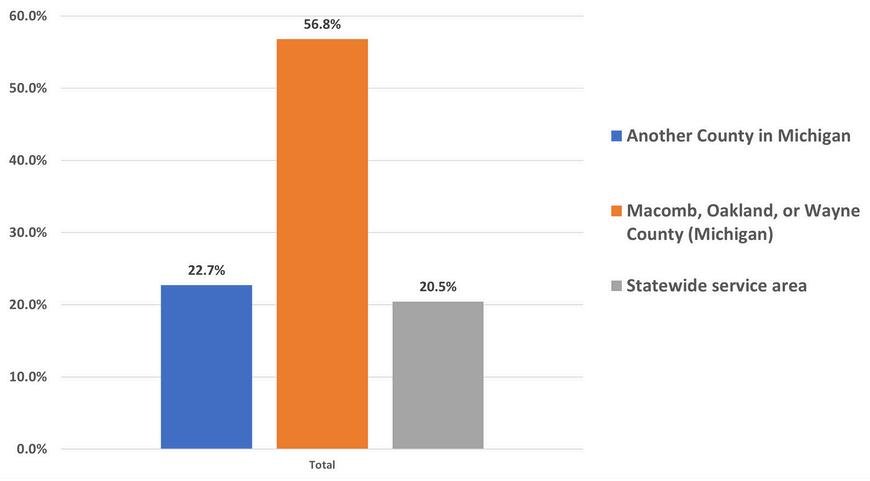
Data collection included key stakeholders such as employers, industry associations, educational institutions, workforce development agencies, and IT professionals to understand and generalize their perspectives on IT skills needed and challenges. Labor market information was also used for benchmarking and assessing the availability of these skills within the current workforce, as well as to identify any significant gaps or opportunities.

The figure highlights the top emerging skills and skill groups that IT employers or employees predict will rise in prominence over the next five years. These include critical thinking and analysis, reasoning, as well as problem-solving, analytical thinking, and innovation which have consistently remained high on the agenda. Using the Lightcast labor market data as a reference, newly emerging skills in self-management, such as resilience, stress tolerance, and flexibility, are also gaining importance. Additionally, active learning and emotional intelligence are expected to be required as emerging skills.
WhichITemergingtechnologieswillhavethegreatestimpactduringthenextfiveyears?
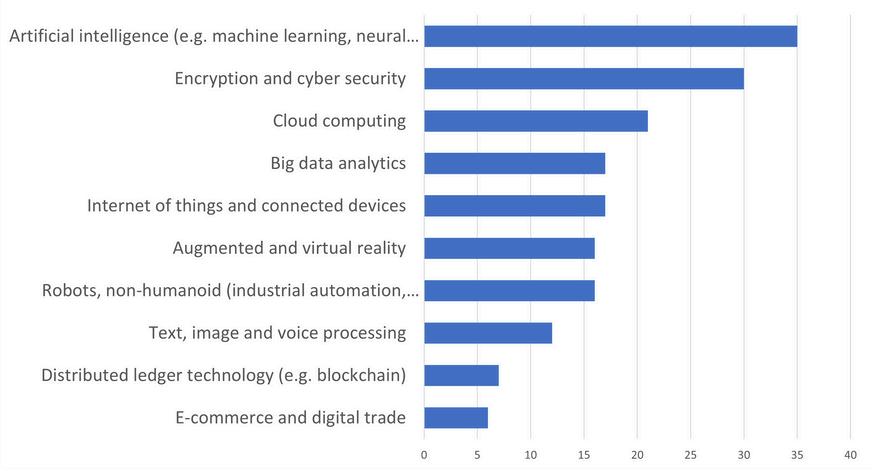
One of the survey questions aimed to identify which emerging IT technologies will significantly influence the next five years. The figure presents a set of high-growth emerging technologies, currently dominated by the AI technology cluster, including machine learning, neural networks, and NLP. The data demonstrates that the integration of AI is significantly influencing IT professionals. The second greatest impact among emerging IT technologies is expected to be in encryption and cybersecurity, followed by cloud computing.
WhatareconsideredthemostimportantgenerativeAIskills?

According to the survey results, the most crucial generative AI skills identified are diverse. Participants emphasized the importance of first understanding the limitations and reliability of AI outputs. Second, respondents underscored the significance of comprehending the impact of AI within their respective fields, emphasizing the need for strategic insight into how AI technologies reshape industries. Additionally, integrating AI with other programs emerged as a critical skill, emphasizing the importance of interoperability and synergy across technological platforms. Finally, prompt engineering was highlighted as a key skill, reflecting the demand for agile and efficient development practices in the context of AI applications.
As technological advancements continue to reshape industries, both individuals and organizations are increasingly focused on up-skilling and re-skilling to remain competitive over the next five years Despite this focus, there are significant challenges to achieving these up-skilling and re-skilling goals


Describeanypersonal upskillingorreskillingplansdue totechnologicaladvancements inthenextfiveyears:
Cloud Computing and AI: Some plan to learn more about cloud computing and AI to integrate these technologies into their work. Tech Savviness: Improving tech savviness is mentioned as a way to keep up with relevant emerging technologies.
Learning and Embracing AI: A few responses indicate intentions to upskill in Linux, the Cloud, and to use AI and automation for business tasks

cation: Some plan to e AI into classroom and curriculum urity and EV Training: plans to focus on rity, electric vehicle (EV) and transitioning to cloud
nce and AI Courses: s are considering courses ence, AI, and cloud g, as well as self-learning atures
Describeanyorganization-wideupskillingorreskillingplansduetotechnological advancementsinthenextfiveyears:
Training and Learning Opportunities
Training on existing software and understanding benefits
Providing learning opportunities for staff to improve proficiency with digital tools and adapt to technological changes
Formal training on new products
Training on Electric Vehicle (EV) adoption and EVSE2
AI Integration and Education
Embracing AI in future plans
Incorporating AI into marketing, data analysis, and forecasting
Integrating AI training for staff
Using Chat GPT on company hardware
Prioritizing AI education and proper use
Companywide AI initiative
Understanding AI and its use in organiza
Reskilling in AI with Data Analysis
Staying on top of AI changes
Integrating AI into workflows
IT and System Changes
Cross-training IT professionals
Moving on-premises systems to the clou
Describethemostsignificantchalle attainingupskillingorreskillinggoa
Challenges to upskilling/reskilling in IT:
Balancing work and personal life
Staying ahead of the IT curve
Accessing quality and relevant training programs
Overcoming complacency
Adapting to rapid changes in AI
Organizational and cost barriers:
Training and reimbursement processes


Availability and affordability of training providers
Cost of AI technology and certification
Creating and applying for grants and apprenticeship programs
Cognitive and ethical issues in AI training:
Education and comprehension challenges
Focusing on complex learning tasks
Trust and acceptance of AI technology
Elimination of cheating and bias
Unintended consequences of AI systems

In the swiftly evolving landscape of information technology, the quest for knowledge remains a pivotal aspect of professional growth. Our recent survey sheds light on the learning modalities that resonate most with IT professionals. Furthermore, there was a meaningful overlap in the data between survey respondents preferences and observations, and real-time job posting analytics data.
WhatisyourpreferenceforlearningnewITskills?


Over 30% of respondents preferred online courses, underscoring the value of flexibility and accessibility in their education. Close behind, an additional 27% preferred workshops while 21% favored on-the-job training, indicating a continued appreciation for interactive and hands-on learning experiences.
Whatspecializeddesignationsorcertifications enhanceemployabilitybeyondacollegedegree?
One key objective of this report was to identify the core technical and soft skills required for various IT roles based on input from stakeholders (primary data) and labor market analysis (secondary data) Another finding from the WIN survey revealed considerable agreement between respondents and the existing job postings data Notably, both sources underscored the importance of certain IT certifications, painting a clear picture of the market’s valuation of expertise
The Certified Information Systems Security Professional (CISSP), CompTIA A+, Cisco Certified Network Associate (CCNA), and Microsoft Certified Professional (MCP) emerged as the most indemand credentials shared across the data sets. This overlap not only validates the relevance of our survey but also highlights the key qualifications that are shaping the IT workforce landscape
As these certifications become the common currency of IT proficiency, they serve as a beacon for aspiring professionals navigating their career paths and for educators tailoring curriculum to meet the industry’s pulse


Learning and education can take on many forms in the modern landscape of talent development Workshops, online courses, internships, and even registered apprenticeship programs (RAP) are all viable ways for prospective employees to gain the skills needed for success in the workplace This array of options is also flexible enough for current workers to pursue up-skilling and re-skilling opportunities As shown below, many employers are also open to supporting RAP
Doesyourorganization currentlyhaveITregistered apprenticeshipprograms?
Ifnot,wouldyouconsider apprenticeshipstomeetyour talentdevelopmentgoals?
The landscape of talent development within the information technology sector is primed for a transition as evidenced by our latest survey results Out of 44 responses, 841% of organizations reported that they do not currently have IT Registered Apprenticeship Programs However, nearly half of these organizations, or 485 percent, are open to the idea of integrating registered apprenticeships into their talent development strategies This openness signals a burgeoning recognition of apprenticeships as a viable conduit for cultivating the next generation of IT professionals By bridging the gap between academic preparation and practical expertise, registered apprenticeships may offer a viable way for organizations to sculpt a workforce that is not only adept at navigating current technological landscapes but also equipped to pioneer the innovations of tomorrow.

HaveanITApprenticeship

The quest to keep pace with advancements in technology presents a multifaceted challenge for today’s IT professionals Across various locales and demographics, there are an array of challenges that prevent the would-be IT workforce of tomorrow from achieving their employment goals Likewise, this creates a gap in talent acquisition for employers and results in a downstream loss of productivity
Whatarethegreatestchallengesinadaptingtotechnologicaladvancementsand acquiringnewITskills?

According to our survey, a significant 38.4% of respondents cited time constraints as the primary hurdle in adapting to new technologies and upskilling. Meanwhile, 31.4% pointed to cost as the primary barrier, underscoring the financial investment required to stay current in a field characterized by rapid innovation. In a distant third, 12.8% of participants expressed difficulty in locating programs that align with their specific professional needs, reflecting a gap in the IT education market. These insights reveal the relative perception of obstacles that IT workers face, highlighting the need for more accessible, cost-effective, and tailored educational opportunities to empower the workforce of the future.
WhatarethemostsignificantchallengesforITtalentacquisition?

Whatdoesa“qualified”candidatemeantoyou?(FocusGroupsummary)
From the WIN survey, 295% of respondents indicated that the most significant challenge for IT talent acquisition is a lack of qualified candidates As we sought to explore the nuances of this topic in further detail, the focus group was quite illuminating According to focus group participants, educational qualifications, such as degrees or certifications, are not a primary consideration for the speaker’s organization Some believe these are not essential to perform a job, potentially because IT is so fragmented in nature Hiring decisions are tailored individually, depending on the specific role Years of experience are considered but are not always a reliable indicator of ability When evaluating a resume’, the focus would be on generic skills, rather than just educational qualifications or specific certifications
Technical skills are important, but the process of assessing them can be flawed due to keyword stuffing in resumes Therefore, they also place significant importance on a candidate’s cultural fit within the organization These points suggest a holistic approach to hiring which values practical skills and cultural alignment over formal education credentials


During phases 2 and 3, the key objectives were to obtain primary data for core and soft skills. These skills are critical for success within current and emerging information technology occupations. The project plan for obtaining this data included surveys, interviews, and a focus group.
Basedonthediscussion,respondentsmentionedseveralITskillsthatarerequiredforsuccessinIT,however, discussionaboutsoftskillsorevenbasicemploymentskillscommandedtheconversation.
Thisincludedcommunication/teamwork/collaboration,problem-solving/troubleshooting,project/time managementandcuriosity/lackoffear/willingnesstolearn.Sometechnicalskillswerementioned,suchas programming,cloudcomputing,anddatabasemanagement.
Additionally,obtainingandmaintainingrelevantITcertificationsordegreeswasalsomentionedasimportant fordemonstratingtechnicalknowledgeandskills
“Curiosity in the end is a core component. If you don't have curiosity this is not the type of role or journey you'll sit in... You can craft the nature of the product you're working on.”
-Jakob, Thoughtworks
What specific areas of IT or AI have recognized skills gaps or need improvement?
AIwasasignificanttopicofdiscussion Therearemanynuances,includingdifferentiationbetweenAIpurposebuiltprogramsandGenerativeAI(genAI)whichisavailabletothemasses Newerprogrammerswithskillsin DataEngineeringandLargelanguagemodelsarelikelytobein-demandforAIDevelopmentroles Becauseof thesharpincreaseindemandforAIprograms,therewillnaturallybeashortageofsupply(workers)withthis specificskillset
Employersmaystruggleto“weedout”candidateswiththerightskillsetsbecausedifferentemployersareoften solvingdifferentproblems.ThisseemstobethenatureofIT.Manycandidatesunderstandhowtocodeina specificprogramminglanguagebutmaynothavethedirectexperienceworkingonthesamespecificproblem Theremayalsobeagapinreasoning/criticalthinkingskillstobestconceptualizetheproblembeingaddressed Thereseemstobesomeconsensusthattheclassroomandcertificationscanonlytakeyousofar.Becauseof thecomplexityandspecificityofIT-relatedprojects,thereisasignificantdemandforhands-onlearning
Employerswantprospectswhohaveworkedonthingsandcanquantifythatexperiencewithprojects They seemtoagreethat,whileclassroomtimeandstudyingforaspecificdesignationlikeCompTIAisvalue-added, thegapseemstobeinactualexperience
Whatareyourobservationsaboutthe readinessorpreparednessofrecentIT graduatesinentry-levelpositions?
Niche-specificskillsareincreasinglyimportant,anda growingnumberofcollegegraduatespossessingthe rightqualificationsforspecializedroles Thejobmarket hasevolvedfromvaluinggenericskillstorequiring specializedexpertiseduetoclientdemandsfor specificskillsets,ie aPythondevelopermaynotbe suitableforadataengineeringrolewithoutadditional knowledge,suchasdatabaseoptimization.Candidates areexpectedtohaveafocusededucationinareaslike machinelearningorcontributionstoopen-source projects.
Portfoliosshowcasingcontributionstoopen-source projectsonplatformslikeGitHubarebecomingmore important,allowinghiringagentstoassessa candidate’sactualcapabilities
Insummary,thereisincreasedimportanceof specializedskillsandpracticalexperience demonstratedthroughtangiblecontributions, reflectingashiftinthehiringlandscapetowardsmore targetedexpertise
“We're trying to figure out what the needs of the industry are right now. And we're getting a lot of Ala carte answers...”
-Patrick, MCC
Whatisthestrategicrolethateducational institutionscanprovidefortheprofessional developmentoftheITlaborforce?
Therewereseveralcommentsfromrespondentsabout specificthingsthatmaybehelpfulfortheup-andcominglaborforce: Short-termtraining Mockinterviews Testingoutof(individually)redundantcourses Resumepreparation
HoweffectivelydocurrentIT(orAI) relatedprogramsandcoursesalignwith industrydemandsandemerging technologies?
Thereseemstobeaconsensusthatcurrent courseworkissufficientforbasicemployment needs(i.e.“footinthedoor”)butfallsshortofmost employerdemands.Thisis,inpart,duetothe natureofcurriculumdevelopmentversusthespeed ofITinnovation Belowaresomehighlightsfrom thisdiscussion:
EducationalProgramDevelopment-Theprocess ofdevelopingandapprovingneweducational programsislengthyandoftencannotkeeppace withtherapidchangesintechnology.Thismakesit challengingforeducatorstoensurethattheir programsremainrelevantandup-to-date
UnderlyingFundamentals-Despitethefastpace oftechnologicalchange,therearefundamental principlesandpatternsthatremainconstantand arestilltaughtineducationalsettings.These fundamentalsareapplicableinreal-worldbusiness scenarios.
IndustryExpectations-Companiesoftenlookfor problem-solversratherthancandidateswitha specificsetofskills Theabilitytoadaptandoffer solutionsishighlyvalued.
BasedonfeedbackfrombothBeau(UPMichigan Works)aswellasPatrick(MCC),thecurrent landscapeofITisoverlyspecific.Thiscreatesa uniquechallengebecausethetrainingneeded doesn’tnecessarilyalignwiththetraditionalformat ofacollegecourse
Furthermore,thespecificitycreatesachallengein gettingsufficientenrollmentandfillingseats
A core component of this research entails identifying the primary technical and common skills needed for various IT roles.
The following content provides insight into the supply and demand of relevant skills for several of the top in-demand IT jobs. This is achieved by comparing the frequency of skills present in real-time job postings against the availability of these skills in today's workforce using online resume’s and candidate profiles.

A core component of this research entails identifying the primary technical and common skills needed for various IT roles. The following content provides insight into the supply and demand of relevant skills for several of the top in-demand IT jobs. This is achieved by comparing the frequency of skills present in realtime job postings against the availability of these skills in today's workforce using online resume’s and candidate profiles
Software Developers are responsible for researching, designing, and developing computer and network software or specialized utility programs They analyze user needs and develop software solutions by applying principles and techniques of computer science, engineering, and mathematical analysis This role involves creating software that meets specific user requirements and enhances business operations
In 2023, the total employment volume for Software Developers was 22,842 in Macomb, Oakland and Wayne counties.
Additionally, there were 12,849 unique job postings during the same time frame. In terms of the skills gap, the most significant differences between frequency of skills found in job postings versus those found in profiles were among the following:
Communication
Problem-Solving
Writing
Planning Innovation
TechnicalSkills
With respect to technical skills, the largest gaps between job postings versus those found in profiles include the following:
Computer Science
Agile Methodology
Debugging
Software Development
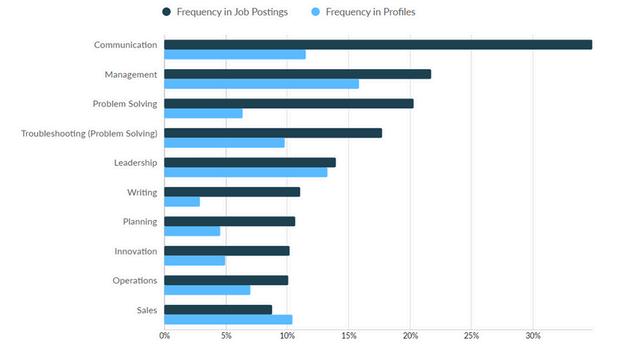
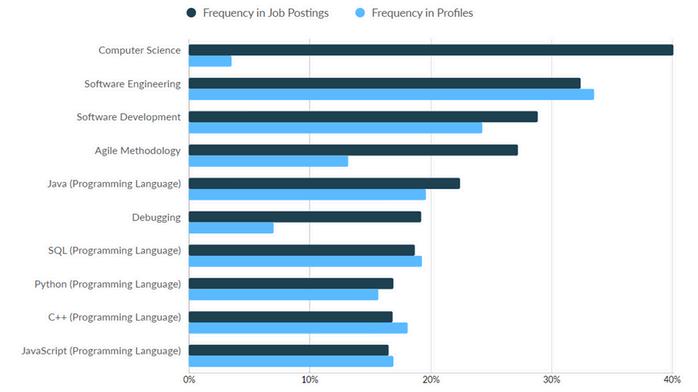
Computer User Support Specialists provide technical assistance to computer users by addressing their questions and resolving computer-related problems. This role involves supporting clients in person, over the phone, or electronically. Support may cover a wide range of issues, including the use of computer hardware and software, installation, troubleshooting, and maintenance.
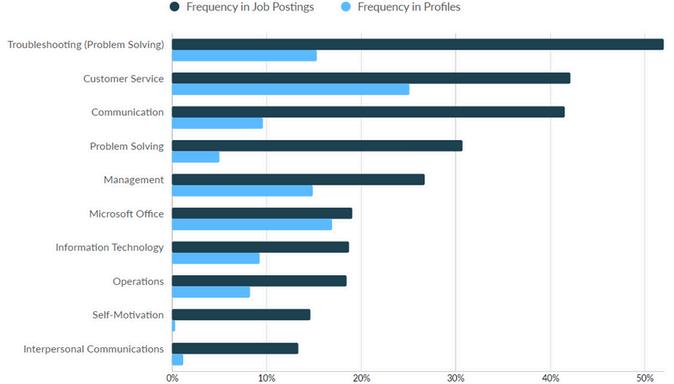
In 2023, the total employment volume for Computer User Support Specialists was 9,597 in Macomb, Oakland and Wayne counties Additionally, there were 3,604 unique job postings during the same time frame In terms of the skills gap, the most significant differences between frequency of skills found in job postings versus those found in profiles were among the following:
Troubleshooting Communication
Customer Service Management
Self-Motivation
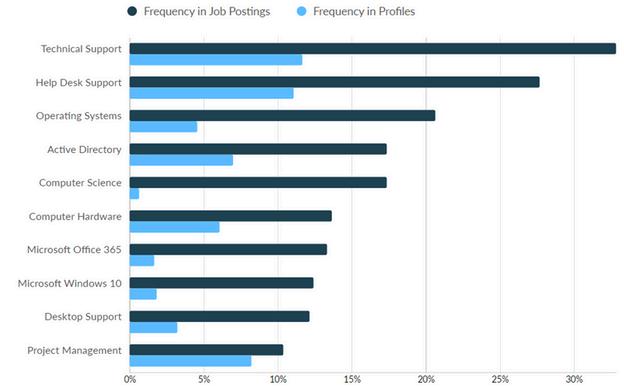
With respect to technical skills, the largest gaps between job postings versus those found in profiles include the following: Technical Support
Help Desk Support
Operating Systems
Active Directory
Computer Science
Computer Hardware
Microsoft Office 365
Microsoft Windows 10
Desktop Support
Computer Systems Analysts are tasked with identifying and resolving data processing challenges in science, engineering, business, and other sectors They develop and implement solutions for complex application issues, system administration challenges, and network problems Their primary responsibilities include enhancing existing computer systems, managing system operations, integrating different technologies, and assessing system capabilities and limitations
CommonSkills
In 2023, the total employment volume for Computer Systems Analysts was 9,060 in Macomb, Oakland and Wayne counties
Additionally, there were 1,715 unique job postings during the same time frame In terms of the skills gap, the most significant differences between frequency of skills found in job postings versus those found in profiles were among the following: Communication
Problem Solving
Planning
Writing
Detail Oriented
TechnicalSkills
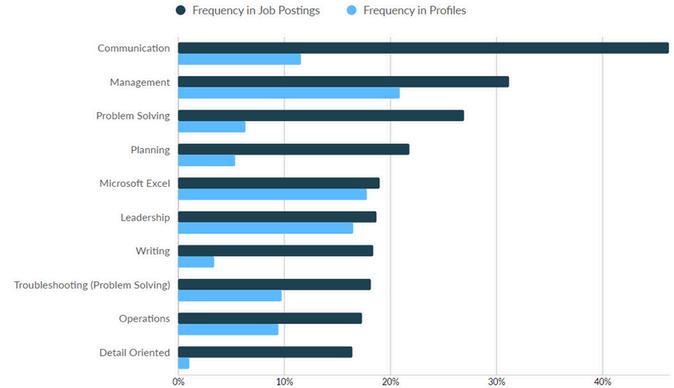
With respect to technical skills, the largest gaps between job postings versus those found in profiles include the following:
Business Process
Business Requirements
Auditing
Workflow Management
Agile Methodology
SQL (Programming Language)

Computer and Information Systems Managers oversee the planning, directing, and coordinating of activities in electronic data processing, information systems, systems analysis, and computer programming They are essential in aligning an organization's technology infrastructure with its strategic business objectives


In 2023, the total employment volume for Computer Systems Analysts was 7,328 in Macomb, Oakland and Wayne counties. Additionally, there were 224 unique job postings during the same time frame. In terms of the skills gap, the most significant differences between frequency of skills found in job postings versus those found in profiles were among the following: Communication Leadership Planning Problem Solving Writing
With respect to technical skills, the largest gaps between job postings versus those found in profiles include the following: Computer Science Information Systems Cyber Security IT Infrastructure
Asrevealedinthepreviousskillgapoutlines,therearemanyoverlappingskillgapsacrossthecommon skillsgroupfortheseITpositions Here,resultshavebeenaggregatedintooneoftwocategories:
FrequentGapsandInfrequentGaps Theobservationthatcommonskillshaveconsiderablymore overlapthantechnicalskillsseemstoconfirmthefocusgroupfindings,whichimplythatITisahighly fragmentedandspecialty-drivenindustry
CommonSkills
FrequentGaps
Communication
Problem-Solving
Writing
Planning

Infrequent Gaps
Innovation
Troubleshooting
Customer Service Management
Self-motivation
Detail Oriented
Leadership
TechnicalSkills
FrequentGaps
Agile
Methodology
Computer Science
Infrequent Gaps
Information Systems
Cyber Security
IT Infrastructure
Business Process
Business Requirements
Auditing
Workflow Management
Agile Methodology
SQL (Programming)
Technical Support
Help Desk Support
Operating Systems
Active Directory
Computer Science
Computer Hardware
Microsoft Office 365
Microsoft Windows 10
Desktop Support
Computer Science
Debugging

Software Development
The following report is based on a comprehensive literature review pertaining to addressing skills gaps through workforce training and development strategies. For many aspects of workforce training there are either few studies that qualify as “best-evidence” or the number of studies is too few for conclusions to be drawn with confidence.
As such, this report has been developed to serve the entire spectrum of workforce development activities, from apprenticeship training to specific education modalities. In some instances, there were sufficient anecdotal frameworks which provided for a general theme.
For this reason, sample training protocols are provided instead of a one-size-fits-all framework Training institutions should tailor the program to the specific needs of their student demographics.

Intoday’srapidlyevolvingITindustry,addressingskillgapshasbecomeacriticalpriorityfororganizations strivingtomaintainacompetitiveedge Effectiveworkforcedevelopmentstrategiesareessentialto bridgethesegaps,ensuringthatemployeesareequippedwiththenecessaryskillstomeetcurrentand futuredemands Byintegratingcomprehensivetrainingprogramsanddynamiccurricula,bothindustry leadersandeducationalinstitutionscancollaborativelyfosterarobustpipelineoftalent Thissynergy betweeneducationandindustrynotonlyenhancestheskillsetsoftheexistingworkforcebutalso preparesthenextgenerationofITprofessionalstothriveinanever-changingtechnologicallandscape.
Implementingthesebestpracticesdemandsaholisticandcoordinatedapproach,whereallstakeholders areactivelyengagedincontinuousdialogueandcollaborationtoequiptheworkforcewiththenecessary skillsfortheevolvingITindustry.Theframeworkillustratedinfigure1.0underscorestheimportanceof collectiveeffortfromallpartiesinvolvedtoeffectivelyaddressskillgapsandenhanceworkforce readiness
Thediagramoutlineskeyactionsrequiredtobridgethesegaps,categorizingthemintofiveprimary stakeholdergroups:Employers,Employees/JobSeekers/Students,EducationProviders,Policymakers, andResearchers Eachgrouphasspecificresponsibilitiesandrecommendedactions,withconnections betweengroupsindicatingareasofcollaborationormutualinfluence
Figure4.1-StakeholderCollaboration
MostoftheresearchanalyzedsuggeststhatoneofthebestwaystoaddressskillgapsinITistoprovide ampleopportunitiesforhands-onlearning Educatorsshouldfocusonreal-worldprojectexperience, industrytools,problem-solvingskills,andeffectivecommunication TheUniversityofCentralFlorida's partnershipwithLockheedMartinexemplifiesthisapproach Despite81%ofcompaniesvaluinglearning andon-the-jobtraining,only34%seereskillingasawaytoincreasetalentavailability Hands-onlearning hasbeenshowntoimprovestudentcomprehensionandreducefailurerates Activelearningtechniques alsoleadtobettereducationaloutcomes,evenifstudentsfeeltheylearnmorefromtraditionallectures Severalitemsemergedforconsiderationduringreviewoftheliterature:
“The most commonly reported knowledge deficiencies that educators should address involve providing some type of real-world project experience, ensuring that students are exposed to the tools most commonly used in the software industry, making sure that students have effective problem solving skills and that they can effectively communicate their solutions to others ”
-Radermacher, Walia, & Knudson, 2014
“While 81% of companies consider investing in learning and on-the-job training to be a key strategy for delivering their business goals... only 34% consider providing reskilling and upskilling to be a way to increase talent availability specifically”
-World Economic Forum, Future of Jobs Survey, 2023
“University of Central Florida has a longstanding partnership with Lockheed Martin called the College Work Experience Program that provides students with hands-on work experience. The program is a paid year-round learning and work experience for full-time students Students collaborate on real projects with Lockheed Martin employees that give students experience while they test different potential avenues for their careers”
-Collins, 2021
“This parameter was measured qualitatively in departmental course coordination meetings. Teaching the core and professional courses was found to be easier by institution's faculty members as the grasping level of student increased due to hands-on component in industry collaborative courses This also resulted in general decrease of failure rates.”
-Misra, 2020
“Study shows students in ‘active learning’ classrooms learn more than they think “For decades, there has been evidence that classroom techniques designed to get students to participate in the learning process produces better educational outcomes at virtually all levels And a new Harvard study suggests it may be important to let students know it The study, published Sept. 4 in the Proceedings of the National Academy of Sciences, shows that, though students felt as if they learned more through traditional lectures, they actually learned more when taking part in classrooms that employed so-called active-learning strategies.”
-Reuell, 2019
Postsecondaryinstitutionsandindustrypartnershipsaimtobridgethegapbetweenacademictraining andemployerexpectationsinarapidlyevolvingjobmarket ProgramsliketheGoogleITcertificateand theCollegeWorkExperienceProgramattheUniversityofCentralFlorida,incollaborationwithLockheed Martin,providestudentswithpracticalskillsandworkexperience.Despitethesesuccessfulexamples, thereisaneedformorewidespreadinfrastructureandincentivestosupportsuchcollaborations, ensuringthatgraduatespossessthetechnical,human,andoccupation-specificskillsrequiredfor workplacesuccess.Furthermore,collaborationscanofferameaningfulwaytobringemployerstothe conversationbyofferingsharedtrainingcostswhileminimizingtheriskoftalentpoaching.Withinthe literaturethatwasreviewed,therewerecertainprogramsthatstoodoutfromtherest,including:
The CyberAmbassadors project, which was recognized for its global impact and funded by the National Science Foundation to enhance communication, teamwork, and leadership skills among CyberInfrastructure professionals. The expansion of professional skills training to college students and professionals across STEM disciplines.
The importance of partnerships between postsecondary institutions and industry, such as Google's IT certificate program with community colleges, to align educational outcomes with employer expectations
The need for collaborative efforts among employers, educators, researchers, policymakers, and learners to address skill gaps and ensure continuous skill development in response to technological changes

In 2023, the CyberAmbassadors project was recognized for its global impact by the American Society for Engineering Education. The CyberAmbassadors project was funded through a workforce development grant from the National Science Foundation. Starting in 2017, the initial focus of this project was to develop, test, and refine new curriculum to help CyberInfrastructure (CI) Professionals strengthen their communications, teamwork and leadership skills. With support and collaboration from a number of academic and professional organizations, the CyberAmbassadors project was expanded to offer professional skills training to college students and professionals working across STEM (science, technology, engineering, math) disciplines (Luchini-Colbry, Joel-Luchini Colbry, Rojewski & Briliyanti, 2019).
“Postsecondary institutions and industry partnerships are an important strategy to close the gap between what colleges produce in their students and what employers expect in their employees. The speed of technological change and job creation and destruction is ever increasing, and postsecondary institutions have struggled to keep pace with the pressing demands for the continuous innovation and upgrading of skills needed in the marketplace For example, technology companies like Google are partnering with community colleges and JFF to

each stakeholder Among others, employers should work on a skill strategy, support the upskilling of their workforce, and define clear requirements of their skill needs towards education providers. Education providers should deliver highly relevant training by understanding industry needs and implementing innovative learning methods. Employees, students, and job seekers should keep themselves updated with the changes impacting their work or future work, and take initiative in learning new skills, as lifelong learning becomes the new normal Policymakers can find the right incentives for the stakeholders to take action, foresee skill needs, and motivate children and other groups to join industry Lastly, the research community should support the collaboration of stakeholders, create skill frameworks for changing jobs, and carry out workshops with employers and employees to understand skill gaps.”
-Braun, Rikala, Jarvinen, Hamalainen & Stahre, 2024
Theapprenticeshipmodelinworkforcedevelopmentisastructuredprogramthatcombinespaidonthe-jobtrainingwithclassroominstruction,allowingworkerstogainpracticalexperiencewhilelearning theoreticalaspectsoftheirtrade Apprenticeshiptraininghasalongandwell-documentedhistoryin moderncivilization Thismodelbenefitsemployersbycreatingapipelineofskilledworkerstailoredto theirspecificneeds,improvingemployeeretention,andboostingproductivity Additionally,itiscosteffective,reducingrecruitmentcostsandfosteringacultureofcontinuouslearninganddevelopment withintheorganization Overall,apprenticeshipshelpaddresstheskillsgapandcontributetoamore engagedandcapableworkforce.Belowareafewexamplesofsuccessfulapprenticeshipprograms identified.
“Bunker Hill Community College’s Learn and Earn internship is an example…Over 150 Learn and Earn students a year earn $18 an hour and a one-time transportation stipend of up to $500 to work in large corporations, small businesses, nonprofits, and civic organizations, directly applying what they learn in the classroom on the job. Since 2016, 11 Bunker Hill Community College partner companies have hired student interns into full-time jobs.”
-Collins, 2021
5 Ways Companies are Addressing Skills Gaps in Their Workforce
“Apprenticeships in the IT and telecommunications sector grew by more than 300% between 2011 and 2020, while cybersecurity apprenticeships grew by 600% during the same period, according to the Department of Labor… Verizon…uses the apprenticeship model to fill software engineering jobs and reports that 95% of an initial cohort accepted full-time offers at the company after completing an apprenticeship program.”
-Chopra-McGowan, 2023

Asdescribedpreviously,onekeyobjectiveofthisliteraturereviewistoprovidevariousframeworksof trainingthatcanbeemulatedatthelocallevel Ratherthanprescribingaspecificsetofcriteria,eachof theprogramsdescribedbelowshouldbeevaluatedforbestfitandpracticality Eachoffersauniqueset ofbenefits,althoughthereisconsiderableoverlapamongstthem
Closing the Skills Gap: Creating Workforce Development Programs that Work for Everyone
“In delivering training, one proven approach is to provide two- to three-month ‘boot camps’ During the boot camp, competency is assessed regularly, based on actual demonstrations Employers collaborate with the training providers and can offer their staff as trainers. The boot camp must be practical, including in-person simulations, on-site apprenticeships, and ‘serious games’ customized to the workplace, where learners can play virtually and repeatedly. Programs need to have a strong in-person component to deliver the necessary dosage of intensive practice and to build the trust that allows providers to support learners At the same time, technology-based solutions, such as online applications, mobile apps that track learner performance, and digital workplace simulations can significantly increase the efficiency and

Engaging Online Learners: The Impact of Web-Based Learning Technology on College Student Engagement
Online learning platforms (Web-based learning) leverage online platforms to provide flexible learning opportunities that can be accessed anywhere, allowing individuals to learn at their own pace Web-based learning in Information Technology (IT) refers to the use of internet technologies and web tools to facilitate and enhance educational experiences This approach leverages online platforms, resources, and tools to deliver, support, and manage learning activities [The Research team] investigates the impact of Web-based learning technology on college student engagement and self-reported learning outcomes in both face-to-face and online learning environments (PuShih Daniel Chen, Amber D Lambert, and Guidry, 2010)
Online classes, specifically Massive Open Online Courses (MOOCs), are demonstrated to be as effective as traditional classroom courses, irrespective of students' initial preparation levels
Conducted by MIT researchers including David Pritchard.
Published in the International Review of Research in Open and Distance
Findings
MOOCs are as effective in teaching as traditional classes
Effectiveness remains consistent regardless of student preparation level
Improvement in learning comparable to or better than traditional lectur
Methodology
Utilized pre- and post-testing for assessment
Applied item-response theory for detailed analysis
Comparative Effectiveness
MOOCs showed equal or better learning gains compared to traditional classes
Interactive engagement pedagogy (students interact frequently in small groups to grapple with concepts and questions) in traditional settings yielded superior results


Potential for further insights from detailed data on student interactions
Study opens avenues for refining educational methodologies in MOOCs
Problem-based learning (PBL) in information technology (IT) is an instructional method where students learn by actively engaging in solving complex, real-world problems Instead of passively receiving information, students are presented with a problem and work collaboratively to research, analyze, and develop solutions. In IT, PBL helps students develop practical skills like problem-solving, critical thinking, and teamwork while also applying theoretical knowledge to real-world scenarios. It’s a hands-on approach that bridges the gap between theory and practice. Outcomes: The study found a positive relationship between the use of learning technology and student engagement and learning outcomes in terms of better understanding of course content, improved grades, and enhanced problem-solving. For instance, students in the PBL group showed a 20% improvement in coding proficiency compared to those in traditional lecture-based courses There was a 30% increase in problem-solving efficiency for students in the PBL group
Problem-Based Learning Program (University of Waterloo - School of Computer Science):
Program: Bachelor of Computer Science (BCS) Co op Program

Cohort-based courses (CBC) emphasize active learning, hands-on projects, and community interaction, enhancing learning outcomes and accountability The community element, especially in regards to young learners who are often introduced to social influence at a young age, taps into the ethos of this generation in a way that other learning modalities do not
“Now, a new delivery format called “cohort-based courses” has emerged as a way to improve completion rates Groups of participants together take a course with defined start and end dates, regular homework assignments, and an instructor to run periodic live online discussion sessions. Within this more structured format, participants still access much of the learning material on their own time, making it easier for them to complete the course and have the chance to apply what they learn over its duration One of the pioneers of this space, altMBA, says its learners have achieved a 96% completion rate Boston Consulting Group (BCG) is one leading employer that has embraced cohort-based courses…Lidia Juszko, BCG’s executive director of global learning and teaming, describes how the format works particularly well for a professional services firm like hers. ‘We’ve found that cohort-based courses offer a level of structure and support that makes them more engaging than standard online learning,’ she said ‘Our colleagues report that the combination and cadence of ‘office hours’ with instructors, live discussion sessions with the rest of the cohort, and short videos and exercises to be completed each week are a more accessible way for them to learn. Learning and development opportunities lik us to continue to attract and retain the best talent.”
-Chopra-McGowan, 2023
“The altMBA one of the most successful online learning experience to date…uses digital tools like Slack, WordPress and Zoom to engage more than 100 students at a time in an intense four-week course altMBA students voluntarily opt-in to the ~3–5 hours of work per day everyday on top of their fulltime jobs during the four week program ‘We spent months looking at different combinations on the x-y axes spectrum and what the trade-offs and gains would be. One of the guiding principles that came out of this questioning was this: Scale isn’t the point Change is the point And once we discarded scale, we added coaches into the mix From there, finding the platonic ideal of 10 coaches, 10 students per coach seemed a natural place to settle.”
-Habif, 2016


Employersandeducationalpartnershipsarecrucialforaddressingskillsgapsbecausetheycreatea directlinkbetweentheskillstaughtineducationalinstitutionsandtheneedsoftheworkforce
Thesepartnershipsallowemployerstocommunicatetheirspecificskillrequirementstoeducators, ensuringthattrainingprogramsarealignedwithindustrydemands Thisalignmenthelpsproducea workforcethatisbetterpreparedandmorecapableofmeetingcurrentandfuturejobrequirements.
Additionally,suchcollaborationscanreducetrainingcostsforemployers,aseducationalinstitutions oftenhavetheresourcesandexpertisetoprovidespecializedtraining.Thesepartnershipsalso enhanceproductivityandemployeeretentionbyfosteringcontinuouslearninganddevelopment Overall,byworkingtogether,employersandeducationalinstitutionscanmoreeffectivelybridgethe skillsgap,leadingtoamorecompetentandcompetitiveworkforce Followingtheanalysisofbest practicestoaddressskillsgaps,thisreviewalsoidentifiesprospectiveemployersandinitiativesto helpsatisfythoseframeworks Abriefreviewofeachisprovidedbelow
GirlsWhoCodeworkstoclosethegendergapinthetechnologyindustrybychangingtheimageof whatprogrammerslooklikeanddo Itconsistsofclubsfor3rd-5thand6th-12thgrades,summer programsforhighschoolstudentsandcollegeandcareerprograms.Withonlyaround24%of individualsintheITprofessionbeingwomen,thereisroomforgreatgrowthinthefieldby expandingeffortstorecruitgirls,women,andnonbinaryindividuals.
Suggestion: Create a College Loop at MCC: Girls Who Code | College Loops There are many clubs near MCC:
2. Iroquois Middle School
3. Gene L. Klida Utica Academy for International Studies
4. Athens High School
5. International Academy East
6. Center Line High School
7. Wilkinson Middle School
8. ROMS GWC Coding Club

CodeforGood(WestMichigan)
CodeforGoodWestMichiganisavolunteerorganizationdedicatedtohelpinglocalnonprofitsthrive throughtechnology Thisorganizationhostsmanyevents,including“WeekendforGood”,“Leadfor Good”,and“WorkshopforGood.”
GuideStarHelpstoKeepComputerScienceTalentinUpperMichigan
“Many of the students in the computer science program are a part of an apprenticeship program with the IT and cybersecurity company Guide Star And so, getting in with them at the high school level and using that as a feeder program is a great strategy for us…
Almost 50 students enrolled in the computer science class in 2024.”
-Rierson, 2024
LocalSoftwareCompanyLaunchesRegion’sFirstApplicationDeveloperRegistered ApprenticeshipProgram
“A first-of-its-kind apprenticeship program in northern Michigan will help a Petoskey based software company train its employees The Pesto Group, in partnership with Northwest Michigan Works!, has launched a unique US Department of Labor registered apprenticeship for Application Developer Registered under the Northwest Michigan Works! U.S. Department of Labor (USDOL) Standards of Apprenticeship, the Pesto Group is providing seven apprentices with 12 months of on-the-job learning along with a minimum of 200 hours of related education… The study plan complements the hands-on learning while providing an innovative, robust experience to expand the career pathways for the apprentices The Pesto Group has partnered with Northwest Michigan Works! to develop our

ThediagrambelowpresentskeybestpracticesidentifiedthroughcomprehensiveITtrainingprograms, diversepedagogicalstrategies,andcurricula,aswellastheactiverolesofstakeholderssuchasemployers andeducationproviders Thesepracticesofferpracticalinsightsforemployers,educators,and policymakersaimedatfosteringthedevelopmentofhigh-demandITskills.
Employerscontinuallyassessevolvingskillrequirements,prioritizingupskillingandreskillingefforts. Educationprovidersareencouragedtoincorporatehands-onlearningopportunitiestoequipITstudents withbothspecializedandbroadlyapplicableskillssoughtbyemployers.
Additionally,jobseekerscanenhancetheircapabilitiesthroughexperientiallearningpathways,including apprenticeships,mentoring,bootcamps,acceleratedtrainingprograms,onlinelearningplatforms,and networkinginitiatives Arangeoflocalprogramssupportingtheseeffortsareavailablewithinthetcountyregion,asillustratedintheBestPracticesDiagrambelow
IdentifyITSkill Needs Continueto Identify Upskills& Reskills Hands-on Experience Web-based Learning Problem-based Learning Program Cohort-based Course Apprenticeship &Mentoring Bootcamps& Accelerated Training Program On-the-job Training OnlineLearning Platform Mentorship& Networking
(Employers, Education Providers, Policymakers & Researchers)
GirlsWhoCode CodeforGood Cyber Ambassador GuideStar (Computer ScienceTalentin UpperMI) LocalSoftware Company LaunchesRegion’s FirstApplication Developer Registered Apprenticeship Program
In the rapidly evolving landscape of information technology, several key trends are poised to shape the future of the industry. Among these, Artificial Intelligence (AI) continues to revolutionize various sectors by enhancing automation, decision-making, and predictive analytics. Cybersecurity remains a critical focus as organizations strive to protect sensitive data and infrastructure from increasingly sophisticated threats Immersive-reality technologies, including virtual and augmented reality, are transforming user experiences and creating new opportunities for interaction and engagement Meanwhile, cloud computing is driving innovation by providing scalable, flexible, and costeffective solutions for data storage and processing. Together, these trends are not only redefining the IT industry but also paving the way for groundbreaking advancements and applications.

WhichITemergingtechnologieswillhavethegreatestimpactduringthenextfiveyears?
Thefigurepresentsasetofhigh-growthemergingtechnologies,currentlydominatedbytheAItechnology cluster,includingmachinelearning,neuralnetworks,andNLP Thedatademonstratesthattheintegration ofAIissignificantlyinfluencingITprofessionals ThesecondgreatestimpactamongemergingIT technologiesisexpectedtobeinencryptionandcybersecurity,followedbycloudcomputing.

Eachtrendisscoredbasedonitslevelofinnovation,interest,investment,andadoption
Innovation, interest, investment, and adoption, by technology trend, 2023

Note: Innovation and interest scores for the 15 trends are relative to one another All 15 trends exhibit high levels of innovation and interest compared with other topics and are also attracting significant investment
1 The innovation score combines the 0–1 scores for patents and research, which are relative to the trends studied The patents score is based on a measure of patent filings, and the research score is based on a measure of research publications
2 The interest score combines the 0–1 scores for news and searches, which are relative to the trends studied The news score is based on a measure of news publications, and the searches score is based on a measure of search engine queries
Rapid Advancements: Gen AI has made significant progress, expanding machine capabilities by producing unique outputs from unstructured data like text, code, images, music, and 3D models.
Notable Models: Models such as OpenAI’s GPT-4, Anthropic’s Claude, Google’s Gemini, and tools like DALLE 3 and Midjourney have achieved impressive results in text and image generation, with new innovations like OpenAI’s Sora for text-to-video generation and Suno for music composition.

Data Source: CB Insights, 2024
Widespread Adoption: Gen AI has sparked significant interest across various regions and industries, with 65% of organizations now using it regularly in at least one business function, a sharp increase from the previous year.
Economic Potential: Gen AI use cases could generate an annual value between $26 trillion to $44 trillion, highlighting its vast economic impact
Scoring the Trend

RapidGrowth: GenAIexperienceda significantsurgein2023,largelydriven bythelate-2022launchofChatGPT.
KeyModels: EarliermodelslikeDALL-E 2andStableDiffusionalsocontributed tothisgrowth
IncreasedInterest:Therewasa sevenfoldincreaseinsearchesand investmentsinGenAIfrom2022to 2023,indicatingheightened excitementandinterestinthe technology
Data Source: Mckinsey & Company, 2024
SignificantGrowth: Since 2019,rolesrelatedtoGenAI haveseena111%increasein jobpostingsby2023.
HighDemand: Thissurgeis fueledbygrowinginterest andinvestmentintheGenAI field.
WidespreadRoleGrowth: AlmostallGenAI-related roles,especiallyindividual contributorpositions,have experiencedanotablerisein demand,withtheexception ofregulationaffairsdirectors

Focus on Scaling: Organizations are prioritizing the expansion of internal capabilities to leverage Gen AI, leading to a sharp increase in demand for data scientists, software engineers, and data engineers.
GenerativeAIDemandSoars1,800%forUSEmployers
In2022,therewereonly519jobpostingscallingforgenerativeAI,Lightcastdatashows Sofarin2023, andsincethedebutofChatGPTinDecember2022,therehavebeen10,113generativeAIpostings,an increaseof1,848% Thereweremorethan385,000postingsforallformsofArtificialIntelligencerolesso farin2023.
MostoftheoccupationsinvolvedarethosealreadyinvolvedinAIdevelopment,suchasMachine LearningEngineersandArtificialIntelligenceEngineers.Thisreflectstheintensedevelopmentprocess companiesaregoingthroughastheydevelopnewapplications

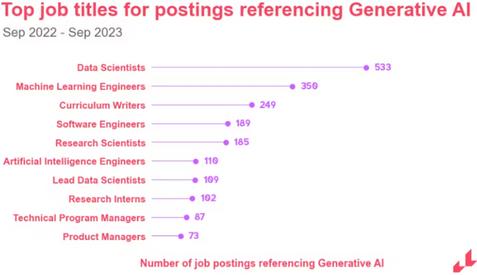
DataAnalysisandContentCreation:GenAIcananalyzevarioustypesofdata,suchastext,images,and voice,enablingthecreationofnewcontentondemand.Thiscapabilityenhancespersonalizationand improvescustomerandemployeeengagementexperiences
CompanieslikeBellCanadaareusingacombinationofgenerativeandpredictiveAItoforeseeand mitigaterisksassociatedwithenvironmentalevents,suchassnowstorms,whichcanleadtonetwork outages.Thispredictivecapabilityallowsforbetterresourceallocationandworkforcereadiness,thereby reducingthecostsassociatedwithmajorservicedisruptions (Predictivemaintenanceandrisk management).
Thetelecommunicationsindustry,whichhaslong struggledwithgrowthandprofitability,isfindingnew opportunitiesformarginimprovementsthroughGenAI By enhancingcustomerlifecyclemanagementandreducing operatingcosts,companiescanachievesignificantreturns oninvestmentwithinafewyears(Profitability improvements).
GenAIisrevolutionizingsalesoperationsbyabsorbingand processingsalesdocumentation,pricingmodels,and customerexperiencedata Thistechnologycanpower advancedchatbotsthatanswersales-relatedqueriesand providereal-timeinsights,enhancingoverallsalesefficiency (SalesOperations).
CustomerService: GenAIboostsagentproductivityby automatingthetranscriptionandsummarizationof customerinteractions Thiscreatessmartercustomer serviceknowledgecentersandimprovesagent performance,leadingtohighercustomersatisfactionand operationalefficiency

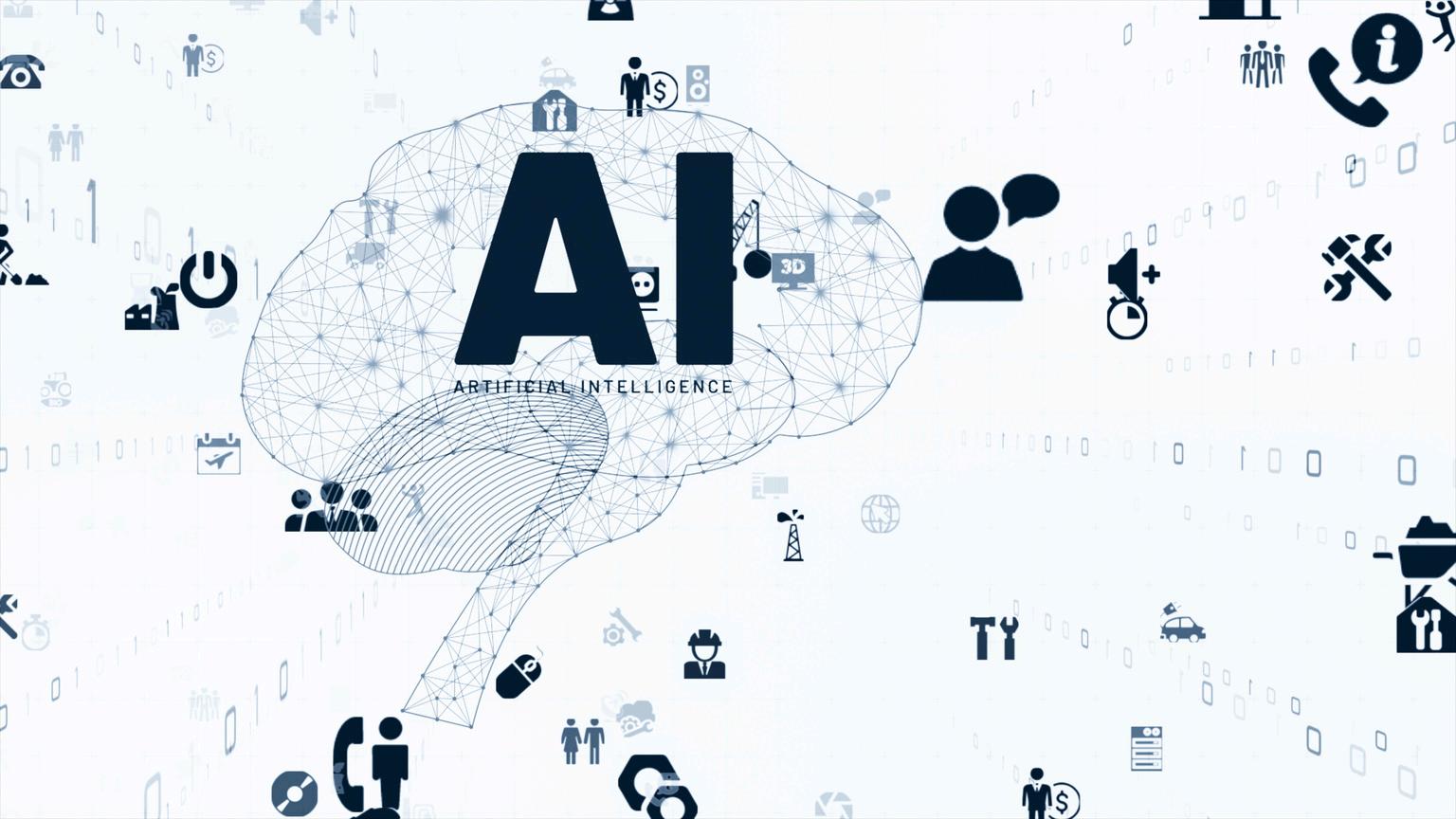
MarketingOperations: GenAIenableshyperpersonalizationinmarketingbyanalyzingcustomerdatato identifysalesleadsandtailorcontenttoindividual preferences Forinstance,aEuropeantelecomprovider reportedlyincreaseditscustomerconversionratesby40% usingGenAItopersonalizemarketingcontent.

Cyber-Attacks Continue to Rise, with AI a Driving Force
Global average weekly cyber-attacks per organization hit an all-time peak in Q2 23

Data Source: CB Insights, 2024
Chat GPT Drives an Explosion of Email Phishing Attacks
One email security vendor recorded a 1,256% increase in phishing emails from Q4 22 to Q3 23
Data Source: CB Insights, 2024

GrowingImportance: Asorganizationsadoptemergingtechnologies(eg,cloudcomputing,appliedAI), theneedforrobustdigitaltrustandcybersecurityisincreasing.
Challenges: Adoptionfaceshurdlessuchasintegrationchallenges,organizationalsilos,talentshortages, andundervaluationasacriticalcomponentofvaluepropositions
LeadershipandStrategy: Realizingthefullbenefitsofdigitaltrustandcybersecurityrequiresstrong leadershipanddeliberatestrategicchangesacrossmultipleareas
KeyRoleinRiskManagement: Digitaltrustandcybersecurityarecrucialformanagingtechnologyand datarisks,acceleratinginnovation,andprotectingorganizationalassets
EnhancingPerformance: Trustindataandtechnologygovernancecanboostorganizationalperformance andimprovecustomerrelationships
RelevantTechnologies: Thistrendincludesdigitalidentity,privacy-enhancingtechnologies,cybersecurity capabilities(likeidentityandaccessmanagement),andWeb3technologies(suchasblockchain)

StrongGrowthin2021: Thecybersecurity marketsawagrowthrateof124%in2021
ImpactofMacroeconomicSlowdown: In 2023,thedigitaltrustandcybersecurity trendexperiencedadeclineininvestment andtalentdemandcomparedto2022,due tothemacroeconomicslowdown.
Long-TermRobustGrowth: Overafiveyearperiod(2019–2023),themarket demonstratedstronggrowthacrossall dimensions
OngoingDigitization: Asenterprises continuetodigitize,thedigitaltrustand cybersecuritytrendisexpectedtokeep gainingmomentum

Job postings for digital trust and cybersecurity decreased by 34% between 2022 and 2023.
Despite the recent decline, there was a 123% increase in job postings between 2019 and 2023.
Security analysts are the most in-demand jobs in this field, followed by software and security engineers.
Salesforce'sEinsteinTrustLayer: SalesforcedevelopedtheEinsteinTrustLayertosecureinteractions betweenusersandlargelanguagemodels(LLMs)withinitsplatform Thissystemmaskspersonally identifiableinformation(PII)beforeitisprocessedbyLLMsandoperateswithazero-retentionarchitecture, ensuringnoSalesforcedataisstoredoutsidetheplatformorusedtotraintheLLM Italsomonitors outputsforinappropriatecontent,enhancingdataconfidentialityandprivacy
Cisco'sTrustPortal: CiscointroducedtheCiscoTrustPortal,aself-servicetoolthatprovidescustomers withon-demandaccesstodocumentsrelatedtosecurity,trust,dataprotection,andprivacycompliance. ThisportalhelpscustomersevaluatethesecurityofCisco'sofferingsandbetterunderstandthecompany's securitymeasures
SkyflowDataPrivacyVault: SkyflowoffersaplatformcalledtheSkyflowDataPrivacyVault,whichactsas asecurecentralhubformanaging,protecting,andutilizingsensitivedata Itisolatesandencryptssensitive datawhileallowinguserstoaccessitthroughsecureAPIswithoutdecryptingtheoriginalinformation, ensuringprivacyandcompliance
FranklinTempleton'sBlockchainMutualFund: FranklinTempletonlaunchedtheFranklinOnChainUS GovernmentMoneyFund,thefirstUS-registeredmutualfundtouseapublicblockchainfortransactions andshareownershiprecords.ByMarch2024,thefundhadexceeded$330millioninassets,usingthe StellarandPolygonblockchains,withplanstoexpandtootherblockchains
Citibank'sCitiTokenServices: CitibankdevelopedCitiTokenServices,ablockchain-basedtokenservice thatconvertsinstitutionalclients'depositsintodigitaltokens Thisservicefacilitatesimmediatecrossborderpayments,liquidity,andautomatedtradefinancesolutions,integratingthesetokenizeddeposits intoCiti'sglobalnetworktoenhanceitscashmanagementandtradefinancefunctions

‘Virtual-reality and augmented-reality experiences are poised to reshape our lives in the coming decade, with innovation driving advancements across both enterprise and consumer use cases Recently, we have seen growth in B2B applications of immersivereality technologies such as spatial computing specifically digital twins gaining traction for training, testing, and design in industrial sectors such as aerospace and defense. On the consumer side, virtual- and augmented-reality experiences are reshaping consumer engagement by offering immersive brand interactions.’
-Eric Hazan, Senior Partner, Paris
2023MarketTrends: Investmentandconsumerdemandforimmersive-realitytechnologiesdeclined significantlyin2023,withstart-upfundingdroppingbyabout50%andVRheadsetsalesdown40% comparedto2022.
NotableDevelopments: Despitefinancialandmarketchallenges,highlightsincludethelaunchofApple’s VisionProheadsetandongoingenterpriseinterestindigital-twintechnology,indicatingsomeresiliencein thesector
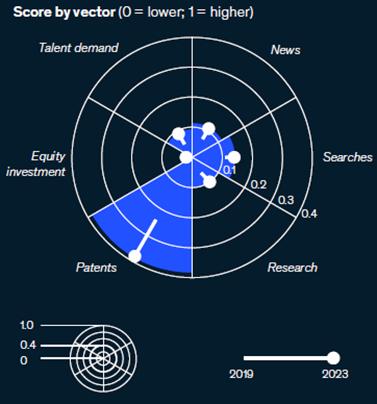
IncreasedActivity: Between2019and2023, therewasanotableriseinscoresacrossnews, searches,publications,andpatentsrelatedto immersive-realitytechnologies
Theincreasessuggestthatcompaniessee significantlong-termpotential indeveloping immersive-realitytechnologies
Continuedinnovationandgrowinginterest pointtotechnologicaladvancementsand explorationofbroaderusecases
BroaderApplications: Newusecasesbeing exploredincludeconsumerengagementand thedevelopmentofdigitaltwins
JobMarketGrowth: Immersive-realityjobpostingshavedoubledsince2020.
2023TalentDemandDecline: Therewasadeclineintalentdemandin2023,indicatingthatthejob marketisadjustingastheindustry’susecasesandsupportstructuresevolve.

InterdisciplinaryField: The immersive-realityfieldintersects technology,art,andbusiness management.
High-DemandRoles: Thereis particularlyhighdemandforgraphic designers,projectmanagers,and mechanical,software,anddesign engineers
DisneyandEpicGamesCollaboration: Disneyacquireda$15billionstakeinEpicGamesand announcedacollaborationtocreateavirtualentertainmentuniverse,allowingconsumerstoengage withDisneycharactersandstoriesthroughgames,shopping,andmediaexperiences.
PorscheandMetaPartnership: PorschepartneredwithMetatouseQuest3MRheadsetsforevent presentationsandvehiclewalk-throughs,enablingsharedVRenvironmentsforproductshowcases.
Mercedes-BenzandNvidiaDigitalTwins:InSeptember2023,Mercedes-BenzimplementeddigitaltwintechnologyonNvidia’sOmniverseplatform,usingdigitaltwinsofitsfactoriesandassemblylines across30locationstooptimizeproductionlinelayouts
AppleVisionProandImmersiveExperiences: FollowingthelaunchofApple’sARheadset,Apple VisionPro,inFebruary2024,companieslikeLowe’sandthePGAbeganleveragingthetechnologyto enhancecustomerexperiences.Lowe’slaunchedanappfor3DARkitchendesign,whilethePGA introducedPGATourVision,allowingfanstovirtuallyexploregolfcoursesduringevents
TransitionfromTraditionalStorage: Enterprisesare movingawayfromtraditionalon-sitestorageand managementtoadistributedapproachacross multipleinfrastructurepoints,includingremote hyperscaledatacentersandon-siteedgeservers
PublicCloudBenefits: Thepubliccloudenables remotehostingofworkloads,offeringscalabilityin computingandstorageresourcesondemand, leadingtoimprovedeconomiesofscale,flexibility, andfasterapplicationdeployment.

EdgeComputingAdvantages: Edgecomputingallowsdatatobeprocessedclosertowhereitis generated,reducinglatency,loweringdata-transfercosts,andenhancingdataprivacy,whilealso complyingwithdataresidencylaws.
AmplifiedAICapabilities: CloudandedgecomputinghaveenhancedAIcapabilities,particularlyfor trainingandinferencingonfoundationalmodels,drivingfurtheradoptionofthesetechnologies.
OptimizingWorkloads: Balancingworkloadsacrosscloud,edge,andintermediatelocationshelps enterprisesoptimizeresources,latency,dataprivacy,andsecurityatscale,unlockingsignificantbusiness value

Investmentscoreshaveincreasedsince2019,with significantfundingduring2020–2022
Innovationscores,includingpatentsand publications,havetrendedupwardsince2019
Interestscoresshowgrowthinsearchactivity,while newssearcheshaveremainedsteady.
Thesetrendsindicatethatearly2020sinvestments arebeingusedtorapidlydeploynewinnovations.
Cloudandedgejobpostingsdecreasedoverallbutremainedhighforsoftwareengineers.
Dataengineersandsoftwaredevelopersexperiencedalargerrelativedecreaseinjobpostings comparedtoothertechnicalroles
ThegrowthofAIsignificantlyinfluencescloudandedgecomputing,leadingtonotablepostingsfor rolessuchasmachinelearning(ML)engineers
McDonald’s and Google Cloud announced a multiyear global partnership to use edge computing for the restaurant’s mobile app, self-service kiosks, and other machinery They will use a combination of Google’s cloud and edge capabilities and McDonald’s own software to draw insights on equipment performance and reduce complexity for staff
“We see tremendous opportunity for growth in our digital business and our partnership with Google Cloud allows us to capitalize on this by leveraging our size and scale to build capabilities and implement solutions at unmatched speeds,” said Brian Rice, McDonald’s Executive Vice President and Global Chief Information Officer. “Connecting our restaurants worldwide to millions of datapoints across our digital ecosystem means tools get sharper, models get smarter, restaurants become easier to operate, and most importantly, the overall experience for our customers and crew gets even better”
-McDonald’s and Google Cloud Announce Strategic Partnership, 2023

Thetechsectorsaw significantlayoffsin2023, especiallyamonglarge techcompanies.
Jobpostingsrelatedtokey techtrendsdeclinedby 26%,asteeperdropthan the17%decreaseinglobal jobpostings
Thedeclinewaslikelydue tocost-cuttingmeasures amidlowerrevenuegrowth projections
Despiteoveralldeclines,job postingsinareaswith stronginvestment,suchas generativeAIand electrification/renewables, increased,reflectinghigh demandforadvancedskills
Asignificantskillsgap exists,withfewerthanhalf ofcandidateshavingindemandtechskills
Despiteshort-term decreases,tech-relatedjob postingsin2023werestill 8%higherthanin2021, indicatingpotentialfor long-termgrowth.


CBINSIGHTS,“2024TechTrends,”2024
Chávez,D.A.,Gámiz-Sánchez,V.,andCañasVargas,A.,“Problem-basedLeaning:EffectsonAcademic PerformanceandPerceptionsofEngineeringStudentsinComputerSciences”JournalofTechnologyand ScienceEducation,”2020
Chen,P,Lambert,A D,Guidry,K R,“Engagingonlinelearners:TheimpactofWeb-basedlearning technologyoncollegestudentengagement”Computers&Education,2010
Chopra-McGowan,A,"5WaysCompaniesAreAddressingSkillsGapsinTheirWorkforce,”June15,2023
Collins,M,“EnsuringaMoreEquitableFuture:AddressingSkillsGapsThroughMultiple,Nuanced Soulutions,”May2021
Habif,S.,“Howtodesignanonlinecoursewitha96%completionrate,”September2016
Hatzius,J,Briggs,J,Kodnani,D,andPierdomenico,G,“ThePotentiallyLargeEffectsofArtificialIntelligence onEconomicGrowth,”GoldmanSachs,2023
Laboissiere,M.,andMourshed,M.,“Closingtheskillsgap:Creatingworkforce-developmentprogramsthat workforeveryone,”Mckinsey&Company,February2017
Lighcast,“GenerativeAIDemandSoars1,800%forUSEmployers,”October2023
Luchini-Colbry,K.,Colbry,D.,Rojewski,J.,andBriliyanti,A.,“PartnersinProfessionalDevelopment:Initial ResultsfromaCollaborationbetweenUniversities,TrainingPrograms,andProfessionalSocieties,”American SocietyforEngineeringEducation,2019
MckinseyDigital,“TechnologyTendsOutlook2024,”July2024
Radermacher,A,Walia,G,andDean,K,“InvestigatingtheSkillGapBetweenGraduatingStudentsand IndustryExpectations,”May2014
Rierson,B,“GuideStarhelpstokeepcomputersciencetalentinUpperMichigan,”June2024
Zahidi,S,“FutureofJobsReport2023,”WorldEconomicForum,May2023
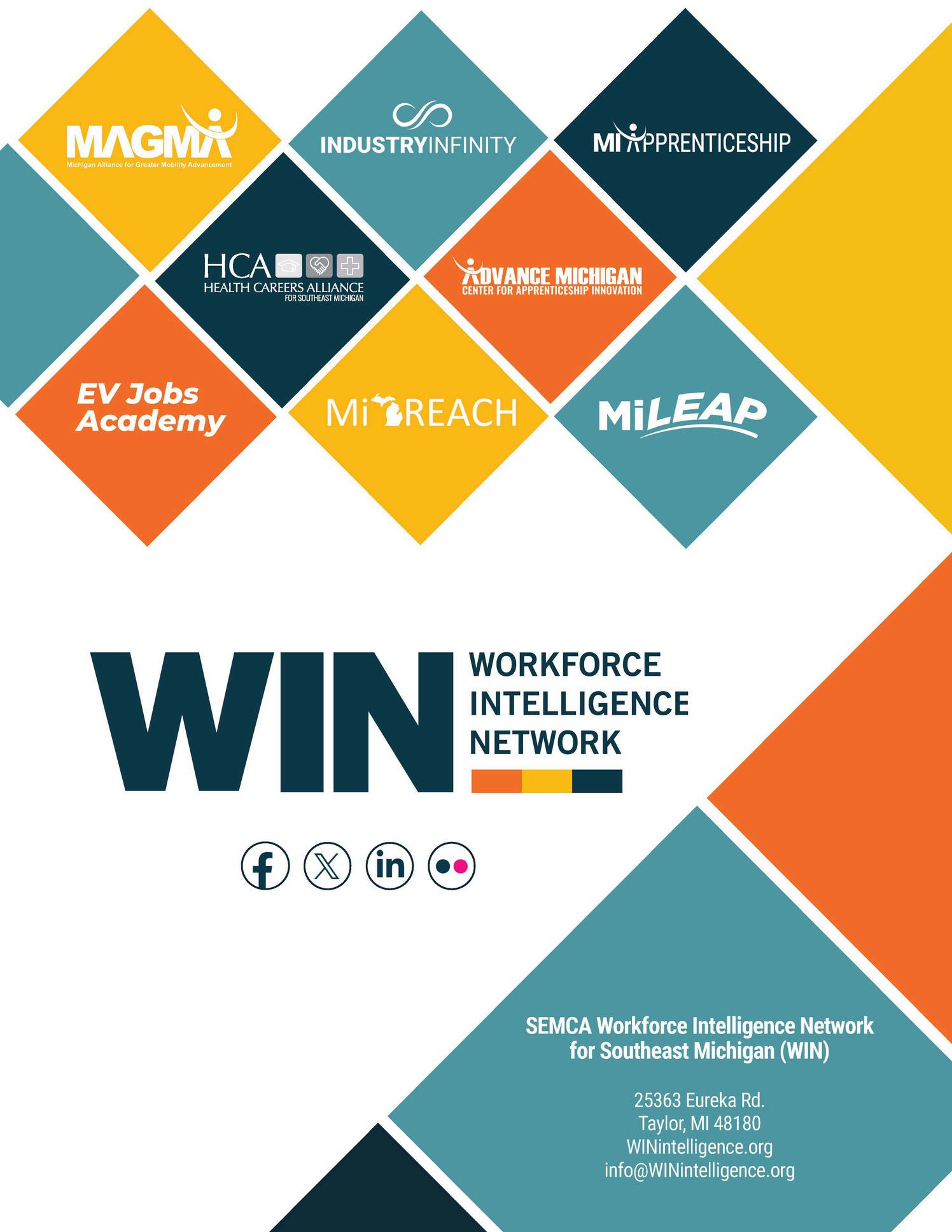
This material is based upon work supported by the US Department of Education under Award Number P116Z230184